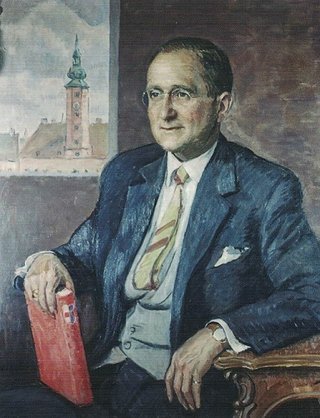Hofrat Dr. Heinrich Raab

Personalia
Born:
Died:
Profession:
Persecution:
Imprisonment March 1938 (two days),
Release 1938
Memberships
Curriculum Vitae
Heinrich Raab was born on St. Blaise's Day as the son of the building contractor Julius Raab (Wohlmeyer company
Heinrich Raab attended the first four years of grammar school in St. Pölten and then transferred to the Benedictine monastery grammar school in Seitenstetten (Matura 1912). He then began studying history and German language and literature at the Faculty of Philosophy at the University of Vienna (Dr. phil. 1919), where he joined the Norica student fraternity. His studies were interrupted in 1914 by military service in the k. u. k. Army in the Field Howitzer Regiment No. 3 (Marburg) (last rank: first lieutenant in the reserve). He was deployed as a battery commander, first on the Eastern Front and then on the Alpine Front.
After the war, Heinrich Raab continued his studies in November 1918 and in 1919 co-founded the secondary school fraternity Nibelungia St. Pölten with his older brother, the later Federal Chancellor Julius Raab, and the later Federal Chancellor Leopold Figl, among others. Heinrich Raab completed his studies in 1919 and passed his teacher training examination for German and history at the end of October 1920. From mid-September 1919, he initially taught at the Cistercian monastery grammar school in Mehrerau near Bregenz, where he maintained contacts with Switzerland, where he met his future wife.
When the Patriotic Front (VF) was founded in 1933, Heinrich Raab became involved with it and immediately became district leader for St. Pölten. Heinrich Raab was appointed government commissioner in 1934 and was later elected mayor by the now corporative municipal council. Numerous building projects are realized during Heinrich Raab's term of office. For example, over 600 council apartments were built during his four-year term of office. With these building measures, he wanted to combat unemployment, which he partially succeeded in doing.
After the annexation of Austria to the German Reich in March 1938, Heinrich Raab was taken into police custody for two days in St. Pölten and dismissed from all his political and professional functions. This dismissal was later retroactively converted into a retirement with half of his pension. After working briefly for a Berlin publishing house, he decides to emigrate to Switzerland and finds a job at the Karl Borromäus cantonal grammar school in Altdorf (canton of Uri), where his wife is from. Due to his stay abroad, he was not paid his raining allowance.
After the war, Heinrich Raab was professionally rehabilitated with effect from May 1, 1945 in a decision dated August 19, 1947, but was not allowed to work at a secondary school. As part of the Foreign Service, he was assigned to the then Austrian legation, and later embassy, in Bern as a press attaché. In the course of the expansion of the Federal Press Service and the associated measures for the uniform deployment of all press attachés, Heinrich Raab was transferred to the staff of the Federal Chancellery-Federal Press Service in 1955 and appointed editor-in-chief (category A). He retired in 1960.
Places
Residence:
Citations
Biolex des ÖCV unter www.oecv.at/biolex; Stand: 10.10.2022.
